Ijraset Journal For Research in Applied Science and Engineering Technology
- Home / Ijraset
- On This Page
- Abstract
- Introduction
- Conclusion
- References
- Copyright
Industrial Automation with Decision and Prediction
Authors: Dr. M. Senthil Kumaran, Vigneshwaran S
DOI Link: https://doi.org/10.22214/ijraset.2024.62928
Certificate: View Certificate
Abstract
This paper presents an innovative approach to automated lighting control that integrates manual, mobile, and intelligent machine-driven operations. The principal aim is to optimize energy economy and user comfort through dynamic lighting control through data collection. To make well-informed decisions about lighting requirements, the system collects user activity data pertaining to time and ambient light levels. The suggested system makes use of sensors to track ambient darkness and identify when a user enters a room. It enables both remote control using a mobile application and manual control using traditional switches. In addition, it analyzes trends in user behavior and ambient variables to autonomously control lighting. The lights are automatically turned on by the system when it detects low light levels and the presence of a user, guaranteeing ideal illumination. Additionally, the system uses machine learning algorithms to forecast lighting needs, which reduces wasteful energy use. In addition to offering a seamless user experience, this adaptive lighting system helps promote sustainable energy practices by using less electricity in areas that are either adequately lighted by natural light or vacant.. This paper demonstrates a comprehensive and user-friendly approach to current lighting systems, opening the door for smarter and more energy-efficient living environments through the combination of manual, mobile, and intelligent controls.
Introduction
I. INTRODUCTION
Optimizing energy use in different situations has become a concern in today's energy-conscious world. Particularly server rooms need a lot of electricity for both lighting and cooling, which increases operating expenses and has an adverse effect on the environment. Conventional lighting and environmental management techniques usually lead to inefficiencies; lights and fans are routinely left on or manually changed, wasting energy. By creating an intelligent lighting and fan control system that maximizes user convenience and energy efficiency, this project seeks to address these issues. Based on real-time data, the system uses a combination of automatic, mobile, and manual controls to dynamically control the lighting and cooling. The system can optimize energy usage by including sensors that track time, user presence, and ambient light levels. The system's ability to assess user interaction data and forecast future behaviour and environmental changes is made possible by the incorporation of machine learning algorithms. By ensuring that lights and fans only run when necessary, this data-driven strategy lowers waste and improves user comfort. Furthermore, the system's capacity to gather and examine usage data offers insightful information about trends and preferences, facilitating ongoing optimization and development. All in all, this project exemplifies a cutting-edge method of building management. By fusing the effectiveness of automatic changes with the adaptability of manual and remote control, it creates a scalable system that can be customized for a range of applications, from commercial and industrial settings to home settings. In addition to lowering operating expenses, this intelligent control system promotes sustainable practices and a greener future by placing a high priority on energy efficiency and user-centric design.
II. PROBLEM STATEMENT
For technology related to computers to operate at its best, server rooms—which are essential infrastructures—need continuous environmental control. Nevertheless, conventional techniques for controlling server room lighting and cooling systems are sometimes ineffective and waste a lot of energy. Often, lights and fans are left on when they are not actually needed, which wastes energy and raises operating expenses. Furthermore, manual control techniques can be laborious and insensitive to changes in the environment or the presence of users in real time..
The following are the main issues this initiative attempts to address:
Excessive Energy Consumption: In server rooms, lights and fans are frequently left on even when not in use, which results in high electricity consumption and higher operating costs.
- Ineffective Manual Adjustments: Manual controls for air conditioning and lighting are ineffective and do not adapt quickly to changing circumstances or the presence of users.
- Absence of Integrated Control Systems: Current solutions don't take a holistic approach to combining automatic, remote, and human controls for the cooling and lighting systems.
- Inadequate Data Utilization: In order to minimize energy usage and boost operational efficiency, there aren't enough technologies in place to gather and analyze environmental data and user engagement.
This project suggests an intelligent control system that combines machine learning algorithms, manual switches, mobile applications, and sensors to address these problems. By utilizing real-time data, user behavior, and environmental factors, this system will automatically modify the lighting and cooling, drastically cutting down on energy use and improving operational effectiveness.
III. PROPOSED SYSTEM
This project suggests an intelligent control system for lighting and cooling in server rooms to address the problems of high energy usage and ineffective manual changes. The system optimizes energy consumption and boosts operating efficiency by integrating several control mechanisms, real-time data collecting, and machine learning. The following is an overview of the main elements and features of the suggested system:
A. Key Components
- Sensations
- Ambient Light Sensors: Use these to gauge when lighting is required based on the amount of ambient light.
- Temperature sensors: Keep an eye on the server room's temperature to efficiently operate the cooling systems.
- Motion sensors: Recognize when people are around to make sure fans and lights are only turned on when necessary.
2. Interfaces for Control
- Manual switches: Give consumers the choice to manually operate fans and lights.
- Mobile application: Provides customers with remote system control, letting them change configurations from their tablets or smartphones.
3. Controller for Automation
- Microcontrollers, also known as home automation hubs, serve as the brains behind the scenes, processing sensor data and controlling lights and fans according to preset schedules and current circumstances.
4. Platform for Analytics and Data Storage
- Cloud-Based Data Storage: Gathers and saves information about user behavior and surrounding.
- Analytics Engine: Examines gathered data to find trends in usage, forecast behavior, and enhance system efficiency.
B. Key Functionalities
- Both remote and manual control
- Physical switches allow users to manually turn on and off fans and lights.
- Users can change settings remotely from any location with the help of the mobile application.
2. Automated Guidance
- Scheduled Operations: According to preset schedules, automatically turn on and off fans and lights.
- Condition-Based Adjustments: Based on temperature, user presence, and ambient light levels in real time, sensor data is used to modify cooling and lighting.
3. Integration of Machine Learning
- Predictive Analytics: Employ machine learning algorithms to examine past data and forecast future actions, guaranteeing that the system adjusts to shifting circumstances and usage trends.
- Optimization: Make ongoing adjustments to schedules and operating rules in response to data insights to continuously optimize energy usage. Integration of Machine Learning:
4. Gathering and Analyzing Data
- User Interaction Logging: Gather information about activities taken by manual and remote control in order to comprehend user behavior and preferences.
- Environmental Monitoring: To enable automated adjustments, record motion, temperature, and ambient light data.
- Reporting and Insights: To offer information about energy use and system performance, create reports and infographics.
C. Benefits
- Energy Efficiency: Reduces unnecessary energy consumption by ensuring lights and fans are only active when needed.
- User Convenience: Combines manual, remote, and automated control options for maximum flexibility and ease of use.
- Operational Efficiency: Enhances server room management by providing real-time adjustments and data-driven optimizations.
- Scalability and Flexibility: Designed to be modular and scalable, allowing for easy integration with other smart systems and adaptation to various environments.
By implementing this intelligent control system, server rooms can achieve significant energy savings, reduce operational costs, and improve overall efficiency, contributing to more sustainable and effective building management practices.
IV. DECISION MAKING SYSTEM INTEGRATION
Decision making integration in your smart control system involves harmonizing multiple components to create an adaptive and efficient environment. Here’s how each element contributes to the integrated decision-making process:
- PIR Sensor: The Passive Infrared (PIR) sensor detects human presence by monitoring infrared radiation levels. When motion is detected, the system decides to activate or deactivate lighting and cooling, ensuring these are only operational when necessary, thus saving energy.
- NODEMCU: Serving as the main controller, the NodeMCU processes data from various sensors and executes decisions based on pre-defined algorithms. It acts as the central hub, integrating data inputs and managing outputs such as turning lights and fans on or off through the relay module.
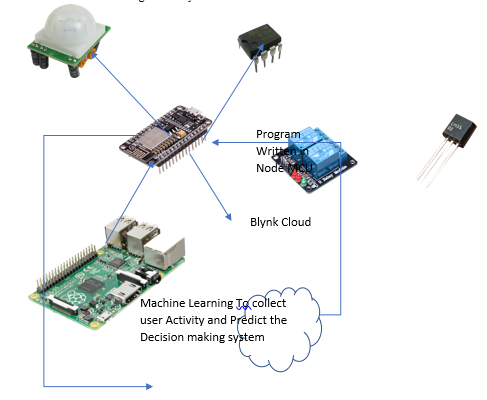
- Relay: The relay module acts as a switch to control high-power devices like lights and fans. Based on the commands received from the NodeMCU, the relay either completes or breaks the circuit, effectively controlling the connected devices.
- Machine Learning Algorithm: By analyzing historical data on environmental conditions and user behavior, the machine learning algorithm predicts future needs. For example, it can learn the typical occupancy patterns and adjust lighting and cooling schedules accordingly, improving efficiency and user comfort.
- Blynk Cloud Application: Blynk provides a user-friendly interface for remote control and monitoring of the system. Through the Blynk app, users can manually override automated decisions, adjust settings, and receive real-time updates on system status. This integration offers flexibility and enhances user engagement.
- Traditional Manual Switches: Manual switches provide a backup and an additional layer of control. Users can override automated decisions instantly, ensuring the system remains user-friendly and adaptable to immediate needs.
- Temperature Sensor: This sensor continuously monitors the ambient temperature in the server room or living space. The data collected informs decisions about when to activate cooling systems, ensuring that the environment remains within optimal temperature ranges without unnecessary energy expenditure.
- Timer Module: The timer module enables scheduled operations, allowing the system to turn devices on or off at specific times. This is useful for maintaining routines, such as ensuring lights are off during non-operational hours or pre-cooling a room before occupancy based on learned patterns.
V. MACHINE LEARNING TECHNIQUES FOR SMART CONTROL SYSTEM
For your smart control system using PIR sensors, NodeMCU, relay modules, Blynk cloud application, traditional manual switches, temperature sensors, and a timer module, here are some suitable machine learning techniques along with descriptions, potential use cases, and corresponding diagrams.
A. Decision Trees
Description: Decision Trees split data into subsets based on the value of input features, creating a tree-like model of decisions.
Use Case: Predict whether to turn on/off lights or fans based on time of day, motion detection, and ambient temperature.
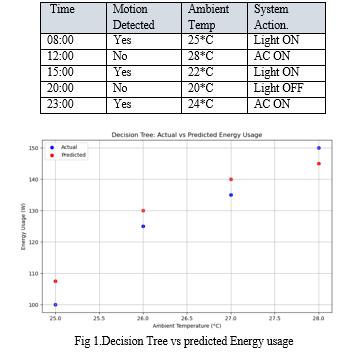
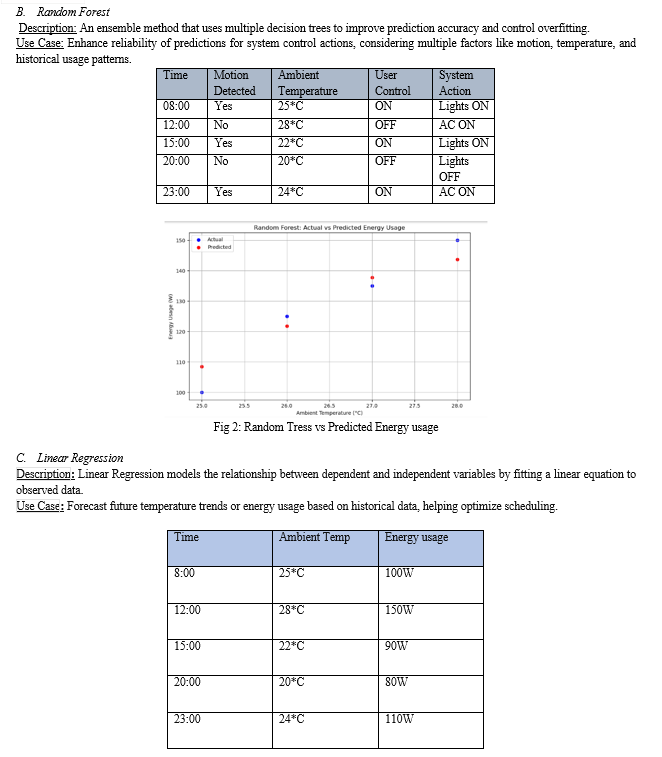
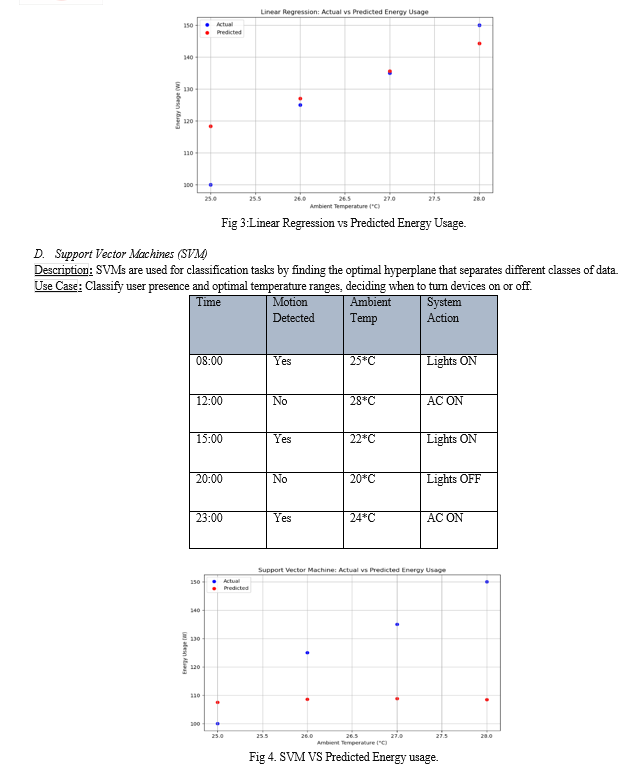
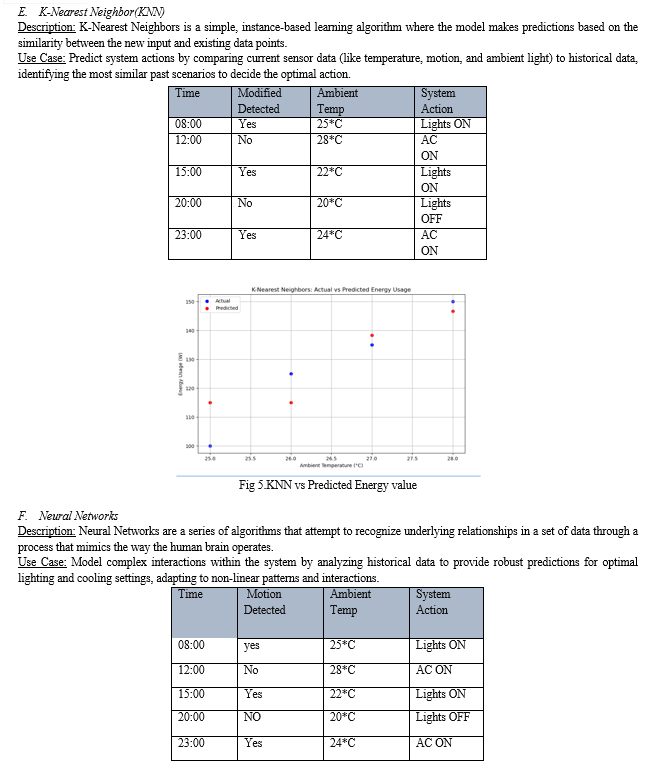
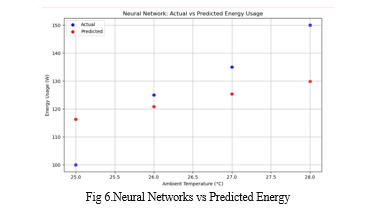
Conclusion
Integrating machine learning techniques into your smart control system significantly enhances its efficiency, responsiveness, and user satisfaction. By leveraging sensors (PIR, temperature), controllers (NodeMCU), relays, and cloud applications (Blynk), along with traditional switches and timer modules, you can create a sophisticated environment that adapts to user behavior and ambient conditions. 1) Decision Trees provide a clear, interpretable model for making binary decisions about system states. 2) Random Forests enhance decision-making reliability through ensemble learning. 3) Support Vector Machines (SVM)effectively classify different operational scenarios based on sensor inputs. 4) Nearest Neighbors (KNN) offer a simple yet powerful method for predicting system states by analyzing similar past instances. 5) Linear Regression helps forecast trends in temperature and energy usage, optimizing the scheduling of system operations. 6) Neural Networks can model complex patterns and interactions within the system, providing robust predictions for optimal settings.
References
[1] Pinak Desai, Nilesh Modi,Volume-8 Issue-6S, April 2019 “Smart Lighting Solution using Clusters of Sensors (Problems with Limited Sensors) and Analyzing Networks for Smart Lighting Solu-tion”. [2] Mohamed Dhiaeddine Messaoudi, Bob-Antoine J. Menelas, Hamid Mcheick “Energy and Economic Analysis of Smart Technologies on Street Lighting System-Modabbir, IEEEaccess 2021. [3] Dr. Lakshmi B N , Dr. Ashwini N , Mr.S Satish Kumar Reddy “Smart Home Automation Using IoT”2021. [4] Dr. Giovanni Pau, Dr. Ilsun You “Internet of Things for Smart Homes ?”2019. [5] N. Satheeskanth, Sakun Marasinghe, R. M. L. M. P. Rathnayaka , A. Kunaraj “IoT-Based Integrated Smart Home Automation System”2019. [6] Dr.Ambujamkathan, G.Gopperumdevi “IOT-BASED ON SMART HOME ISSUES SECURITY AND PRIVACY SYSTEM” 2021. [7] Abdullah Al Arafat, “Machine learning techniques for IoT security: Current research and future vision with generative AI and large language models Machine Learning in Real-Time Internet of Things (IoT) Systems: A Survey”2021. [8] Fatima Hussain, Rasheed Hussain, Syed Ali Hassan, Ekram Hossain Machine Learning in IoT Security: Current Solutions and Future Challenges 2019. [9] Rajkumar Kotteswaran, U. Hariharan Impact of IoT?Enabled Smart Cities: A Systematic Review and Challenge s2019.
Copyright
Copyright © 2024 Dr. M. Senthil Kumaran, Vigneshwaran S. This is an open access article distributed under the Creative Commons Attribution License, which permits unrestricted use, distribution, and reproduction in any medium, provided the original work is properly cited.

Download Paper
Paper Id : IJRASET62928
Publish Date : 2024-05-29
ISSN : 2321-9653
Publisher Name : IJRASET
DOI Link : Click Here
 Submit Paper Online
Submit Paper Online

